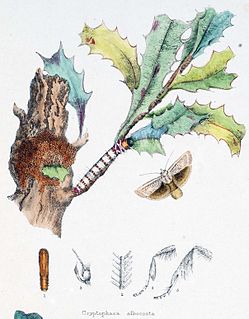Related Research Articles

Xyloryctidae is a family of moths contained within the superfamily Gelechioidea described by Edward Meyrick in 1890. Most genera are found in the Indo-Australian region. While many of these moths are tiny, some members of the family grow to a wingspan of up to 66 mm, making them giants among the micromoths.
Helcystogramma augusta is a moth in the family Gelechiidae. It was described by Meyrick in 1911. It is known from north-eastern India.
Dichomeris dicausta is a moth in the family Gelechiidae. It was described by Meyrick in 1913. It is found in India (Assam).
Charistica caeligena is a moth in the family Gelechiidae. It was described by Edward Meyrick in 1922. It is found in Amazonas, Brazil.
Commatica xanthocarpa is a moth in the family Gelechiidae. It was described by Edward Meyrick in 1922. It is found in Peru.
Pyncostola ochraula is a moth of the family Gelechiidae. It was described by Meyrick in 1918. It is found in South Africa, where it has been recorded from Gauteng.
Polyhymno chionarcha is a moth of the family Gelechiidae. It was described by Meyrick in 1913. It is found in Mozambique, Namibia, South Africa, Tanzania and Zimbabwe.
Polyhymno intorta is a moth of the family Gelechiidae. It was described by Meyrick in 1918. It is found in South Africa (KwaZulu-Natal).

Cryptophasa is a genus of moths of the family Xyloryctidae.
Cryptophasa nesograpta is a moth in the family Xyloryctidae. It was described by Edward Meyrick in 1925. It is found on New Guinea.
Cryptophasa vacuefacta is a moth in the family Xyloryctidae. It was described by Edward Meyrick in 1925. It is found on New Guinea.
Cryptophasa hormocrossa is a moth in the family Xyloryctidae. It was described by Edward Meyrick in 1925. It is found on New Guinea.
Cryptophasa mesotoma is a moth in the family Xyloryctidae. It was described by Edward Meyrick in 1925. It is found on Buru in the Maluku Islands.
Cryptophasa amphicroca is a moth in the family Xyloryctidae. It was described by Edward Meyrick in 1925. It is found on New Guinea.
Cryptophasa chionotarsa is a moth in the family Xyloryctidae. It was described by Edward Meyrick in 1925. It is found on New Guinea.
Cryptophasa ensigera is a moth in the family Xyloryctidae. It was described by Edward Meyrick in 1925. It is found on New Guinea.
Cryptophasa malevolens is a moth in the family Xyloryctidae. It was described by Edward Meyrick in 1928. It is found on New Guinea.
Cryptophasa megalorma is a moth in the family Xyloryctidae. It was described by Edward Meyrick in 1910. It is found on New Guinea.
Cryptophasa tetrazona is a moth in the family Xyloryctidae. It was described by Oswald Bertram Lower in 1901. It is found in Australia, where it has been recorded from New South Wales, Queensland, Victoria and Western Australia.
Cryptophasa citrinopa is a moth in the family Xyloryctidae. It was described by Oswald Bertram Lower in 1915. It is found in Australia, where it has been recorded from New South Wales and Queensland.
References
- ↑ "Cryptophasa crocochorda". Insecta.pro.
- ↑ "Cryptophasa crocochorda definition/meaning". Omnilexica.
- ↑ Savela, Markku, ed. (April 25, 2016). "Cryptophasa crocochorda Meyrick, 1925". Lepidoptera and Some Other Life Forms. Retrieved August 24, 2020.
- ↑ Exotic Microlepidoptera. 3 (5-7): 151.
| This article on a moth of the family Xyloryctidae is a stub. You can help Wikipedia by expanding it. |